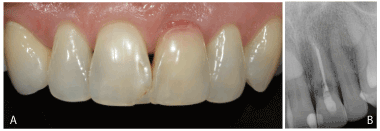
Figure 1: (A) Preoperative frontal view; (B) Preoperative preapical radiograph of maxillary left central incisor

Ramtin Sadid-Zadeh1* Antigoni Stylianou2 Perng-Ru Liu3 Sandra J O’Neal4
1Department of Prosthodontics, University at Buffalo School of Dental Medicine, Buffalo, NY, USA*Corresponding author: Dr. Ramtin Sadid-Zadeh, Assistant Professor, 1Department of Prosthodontics, University at Buffalo School of Dental Medicine, Buffalo, NY, USA, Tele: (716) 829- 6361; E-mail: rsadidza@buffalo.edu
Treatment outcome of prosthetic restorations in the aesthetic zone is potentially subjected to change following the dynamic status of the oral environment. Long-term evaluation of these restorations can reveal a less aesthetic appearance due to alteration of the surrounded soft tissue. The aim of this clinical report is to present a prosthetically oriented technique that may contribute to the enhancement of soft tissue appearance of implant-supported restorations in the aesthetic zone if mid facial recession occurs. Particularly, this approach utilizes a biomimetically fabricated implant abutment consisting of the pink subgingival portion and the white supragingival portion to mimic the soft tissue and tooth structure shades, respectively.
Aesthetic outcome of prosthetic restorations is potentially subjected to change following soft tissue dynamics of treated areas. The need for prevention of soft tissue recession following single implant placement is essential, especially in the aesthetic zone. Soft tissue alterations found to be more critical in patients with high smile line and thin-scalloped gingival biotype [1,2].
Numerous studies have been conducted to evaluate the amount of soft tissue recession following single implant-supported restoration. The results of the studies suggest that soft tissue recession varies between 0.56 and 1.5 mm after 1-3 years of follow-up results [3-13].
When midfacial recession occurs in the restored aesthetic zone, harmony between artificial crowns and surrounding soft tissue is disturbed. The fabrication of an implant abutment with a subgingival soft tissue colored part might contribute in balancing the clinically visible white and pink disproportion in the event of soft tissue alterations. The purpose of this article is to present a method in which implant abutment follows white and pink esthetic analogies of the tooth structure and surrounding soft tissue complex.
56 year-old Caucasian female presented to the Postgraduate Prosthodontics Clinic of University of Alabama at Birmingham, School of Dentistry for evaluation of restorability of maxillary left central incisor. Clinical and radiographic evaluation revealed the endodontically treated tooth, associated with external cervical resorption and pink spot discoloration on the cervical area (Figures 1A and 1B). The patient’s medical history was noncontributory, and there were no contraindications for dental treatment. Periodontal examination of the tooth showed thick gingival biotype with probing depth of less than 3 mm and mild bleeding on probing. Smile analysis showed high smile line displaying gingival margin during full smile. Tempromandibular joint and mandibular range of motion were within normal limits and asymptomatic. To develop a treatment plan, diagnostic impressions were made with irreversible hydrocolid (Jeltrate Alginate, DENTSPLY International Inc. York, PA, USA), and centric relation was recorded using bimanual manipulation. An arbitrary hinge axis was used to transfer casts to a semi-adjustable articulator (Whip Mix Corporation, Louisville, KY, USA).
Combining data from all diagnostic findings, the tooth was rendered non-restorable with compromised long-term prognosis. Definite treatment plan included surgical removal of the tooth, socket grafting, and implant-supported single crown.
Atraumatic extraction along with socket grafting was performed for the central incisor due to labial dehiscence. The site was grafted using allograft material (Puros® Cortico-Cancellous Particulate Allograft, Zimmer Dental, Carlsbad, CA,USA), resorbable collagen wound dressing (CollaPlug Absorbable Collagen Wound Dressing, Zimmer Dental) and connective tissue graft harvested from the patient hard palate. The site was temporarily restored using composite resin (Filtek Supreme Ultra Universal Restorative, 3M ESPE, St. Paul, MN, USA) bonded to the adjacent teeth and secured by orthodontic wire (Figure 2). After 6 months, an implant (3.5 mm diameter, 13 mm length, NobelActive™ Internal NP, Nobel Biocare, Yorba Linda, CA, USA) was placed with primary stability of 35 N.cm. A chairside immediate cement-retained implant-supported provisional restoration was fabricated using two-piece immediate temporary abutment (NobelActive™ Internal, Nobel Biocare), autopolymerizing acrylic resin (Jet Tooth Shade Acrylic, Lang Dental, Wheeling, IL, USA), and a clear matrix formed from the diagnostic wax up (Figure 3). The restoration was adjusted to eliminate any occlusal interference in centric relation position and excursive movements.

Figure 1: (A) Preoperative frontal view; (B) Preoperative preapical radiograph of maxillary left central incisor
Six months later, a closed-tray implant-level definitive impression was recorded with a silicone impression material (Aquasil, DENTSPLY Caulk, Milford, DE, USA) using a stock tray (DENTSPLY Caulk, Milford, DE, USA) and titanium impression post (Nobel Biocare, Yorba Linda, CA, USA). Implant analog (Implant Analog, Nobel Biocare, Yorba Linda, CA, USA) was placed on the impression post and soft tissue was reproduced using polyvinylsiloxane (Gingitech, Ivoclar Vivadent, Amherst, NY, USA). Definitive cast was poured in low-expansion die stone (Silky-Rock Die Stone, Whip Mix, Louisville, KY, USA) and cross-mounted with diagnostic wax-up.
Two-piece interim abutment was designed and milled following the diagnostic wax-up and the definitive cast (ZirkonZahn USA, Atlanta, GA, USA). The Interim abutment was first milled from polymethylmethacrylate (PMMA) block (Temp Basic, ZirkonZahn USA, Atlanta, GA, USA) and then luted to Titanium abutment (Temporary Abutment Engaging Conical Connection NP, NobelBiocare, Yorba Linda, CA, USA) using adhesive luting composite (Multilink Implant, Ivoclar Vivadent, Amherst, NY, USA). Similarly, Interim crown was scanned and copy milled (CAD/CAM System S-TEC, Zirkonzahn GmbH, Gais, Italy) from PMMA block (Temp Basic, ZirkonZahn USA) to fit the fabricated interim abutment. Subgingival portion of the provisional abutment was cut back and replaced by pink composite resin (ZirkonZahn USA, Atlanta, GA, USA) following tissue contour (Figure 4A). Provisional abutment and crown were tried-in to evaluate abutment and crown contours. If modifications were needed, they were made chair side (Figure 4B). Tooth and tissue shade were selected and digitally recorded using Vita Tooth guide 3-D Master (Vident, Brea, CA, USA) and pink gingival shade guide (IPS e.max Ceram Gingiva Shade Guide, Ivoclar Vivadent, Amherst, NY, USA). The definitive cast, shade guides, modified interim abutment and crown were returned to the milling center (Zirkonzahn USA lab, Atlanta, GA, USA) for fabrication of definitive abutment and crown.
The milled interim abutment and crown were scanned and copy milled (CAD/CAM System S-TEC, Zirkonzahn GmbH, Gais, Italy) from a pre sintered Zirconia blank (Prettau Zirconia, Zirkonzahn GmbH, Gais, Italy). Milled zirconia was stained following the biologic shade of peri-implant structure, subgingival and supragingival portions of the abutment were stained pink (ICE Zirkon stain, ZirkonZahn USA) and tooth color (ICE Zirkon stain, ZirkonZahn USA), respectively and then sintered at 1,600 (Sintering Furnace 600/V3, Zirkonzahn GmbH, Gais, Italy) for 2 hours. External tissue stain (ICE Zirkon stain, ZirkonZahn USA) was placed on the subgingival portion of the abutment to achieve optimum tissue color. Then, Zirconia portion of the two-piece abutment was luted to the titanium cylinder (Nobel Biocare, Yorba Linda, CA, USA) after surface treatment with aluminum oxide and Monobond plus primer (Ivoclar Vivadent, Amherst, NY, USA), using Multilink Implant cement (Ivoclar Vivadent, Amherst, NY, USA), following manufacturer’s instructions (Figure 5). Subsequently, IPS e.max Press (Ivoclar Vivadent, Amherst, NY, USA) ceramic restoration was fabricated following contour of interim crown.
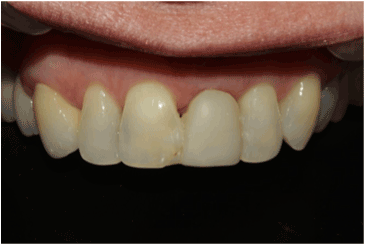
Figure 2: Cement-retained implant-supported interim restoration
Upon receiving the definitive abutment and crown, the definitive abutment was torqued at 35 N.cm (Figure 6) twice with interval time of 10 Min and definitive crown was cemented using RelyX Luting Plus Cement (3M ESPE, St. Paul, MN, USA) following manufacturer’s instruction. Before and after picture of the patient smile is depicted in Figures 7A and 7B. Patient was followed-up at 2-week recall and thereafter, at 6-month recall intervals uneventfully (Figure 8).
The multifactorial dependence of the soft tissue recession, underlines the unpredictable character of its outcome in every implant treatment attempt. Different treatment approaches have been suggested to improve the amount of soft tissue recession including placement position of the implant [14], surgical augmentation of keratinized tissue [15], flapless surgical placement of the implant [15], and immediate provsionalization [16,17].
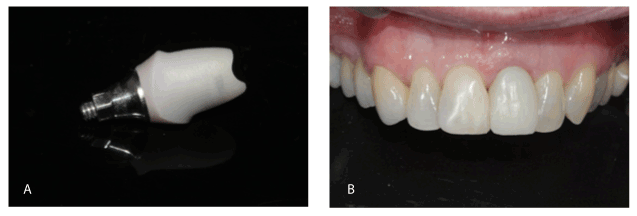
Figure 3: (A) Pink-white milled interim abutment; (B) Milled cementretained implant-supported interim restoration
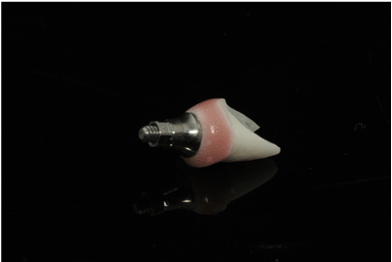
Figure 4: Pink-White two-piece zirconia abutment
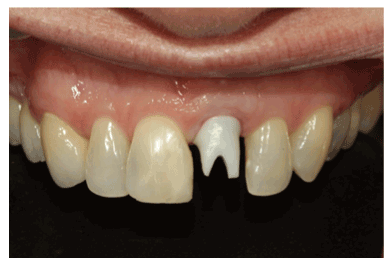
Figure 5: Intraoral view of pink-white two-piece zirconia abutment
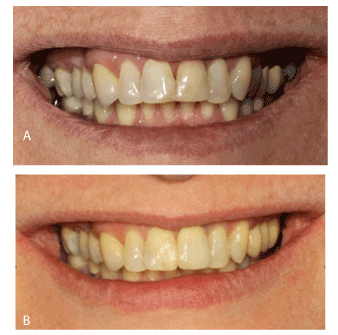
Figure 6: Patient smile (A) before the treatment; (B) immediately after delivery of the definitive crown
Overall, it has been found that in the presence of an intact buccal bone wall, thick gingival biotype, flapless approach of surgical procedures and direct placement of provisional restoration after immediate implantation, the risk of advanced midfacial recession can be significantly lessened by approximately 10% [18]. In addition to the above mentioned techniques, implants with a conical connection and platform switching [19] and the selection of the prosthetic components contributes significantly in the achievement of an aesthetic surrounding gingival tissue [20,21].
The subgingival configuration of the restoration is critical for the biologic integrity and aesthetic acceptance [22]. Zirconium oxide abutments have been introduced in an effort to create more aesthetic gingival architect when compared to conventional metal abutments [23]. However, the white color of the zirconium oxide in patients whom encounter soft tissue recession or show through the thin mucosa may have a negative impact on the naturally colored effect [22]. On the other hand, several applications of pink ceramic [24] or pink composite resin material [25-27] have been used in masking gingival defects where surgical intervention was not a treatment of choice.
Regarding this patient presentation, clinical evaluation of two-piece pink-white zirconia abutment revealed an acceptable esthetic and good soft tissue adaptation. The treatment goal of the fabrication of pink-white zirconia abutment to address the esthetic effect of potential soft tissue recession has been accomplished. In the event of midfacial recession, the exposed pink portion will preserve the pink-white balance of soft tissue and ceramic crown respectively as well as the initially achieved esthetic appearance of the restoration.
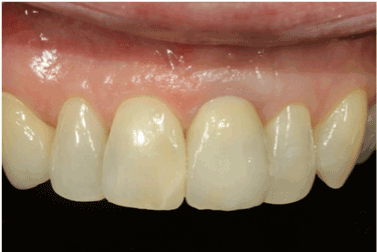
Figure 7: Intraoral view of implant-supported crown at 6-month follow up
Functional and esthetic rehabilitative outcome is intimately depended by both prosthetic and peri-implant components. Despite of surgical interventions, facial tissue recession varying from 0.56 to 1.5 mm is predicted [3-13]. This clinical report illustrates a non-invasive and prosthetically oriented technique to overcome the potential esthetic complication in the likelihood of midfacial recession after definitive restoration of an implant in the esthetic zone.
Download Provisional PDF Here
Article Type: Case Report
Citation: Sadid-Zadeh R, Stylianou A, Liu PR, J O’Neal S (2015) Biomimetic Zirconia Abutment for Single Implant Supported Restoration: A Case Report. Int J Dent Oral Health 1(3): doi http://dx.doi. org/10.16966/2378-7090.119
Copyright: ©2015, Sadid-Zadeh R, et al. This is an open-access article distributed under the terms of the Creative Commons Attribution License, which permits unrestricted use, distribution, and reproduction in any medium, provided the original author and source are credited.
Publication history:
All Sci Forschen Journals are Open Access